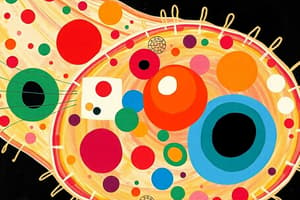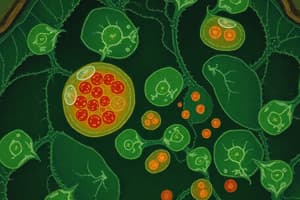Podcast
Questions and Answers
Which statement accurately describes a difference between prokaryotic and eukaryotic cells?
Which statement accurately describes a difference between prokaryotic and eukaryotic cells?
- Eukaryotic cells have membrane-bound organelles, while prokaryotic cells lack them. (correct)
- Prokaryotic cells have a nucleus, while eukaryotic cells do not.
- Eukaryotic cells reproduce asexually, while prokaryotic cells reproduce sexually.
- Prokaryotic cells are typically larger than eukaryotic cells.
What is the main function of ribosomes in a cell?
What is the main function of ribosomes in a cell?
- Storage of genetic information.
- Transport of materials across the cell membrane.
- Energy production through cellular respiration.
- Synthesis of proteins. (correct)
Which phase of the cell cycle is characterized by DNA replication?
Which phase of the cell cycle is characterized by DNA replication?
- G1 phase
- G2 phase
- S phase (correct)
- M phase
What is the significance of meiosis in sexual reproduction?
What is the significance of meiosis in sexual reproduction?
Which of the following best describes the structure of DNA?
Which of the following best describes the structure of DNA?
Which of Mendel's laws states that allele pairs separate independently during gamete formation?
Which of Mendel's laws states that allele pairs separate independently during gamete formation?
What type of inheritance pattern is exhibited when one allele is not completely dominant over another?
What type of inheritance pattern is exhibited when one allele is not completely dominant over another?
Which of the following organelles is primarily involved in the production of ATP?
Which of the following organelles is primarily involved in the production of ATP?
What is a key characteristic of cancer cells?
What is a key characteristic of cancer cells?
Which type of biological molecule functions primarily in long-term energy storage?
Which type of biological molecule functions primarily in long-term energy storage?
What is the primary mechanism by which Darwin explained the process of evolution?
What is the primary mechanism by which Darwin explained the process of evolution?
Which of the following best describes a geographic isolation mechanism in speciation?
Which of the following best describes a geographic isolation mechanism in speciation?
Which of the following factors does NOT affect genetic equilibrium according to Hardy Weinberg's principle?
Which of the following factors does NOT affect genetic equilibrium according to Hardy Weinberg's principle?
What is the primary function of enzymes in the digestive system?
What is the primary function of enzymes in the digestive system?
Which of the following best illustrates a predator-prey relationship in an ecosystem?
Which of the following best illustrates a predator-prey relationship in an ecosystem?
Which process is primarily responsible for the loss of biodiversity?
Which process is primarily responsible for the loss of biodiversity?
What is the main process through which plants convert sunlight into energy?
What is the main process through which plants convert sunlight into energy?
In the context of human physiology, what is the primary role of the circulatory system?
In the context of human physiology, what is the primary role of the circulatory system?
What is a fundamental effect of global warming on the environment?
What is a fundamental effect of global warming on the environment?
Which of the following is NOT a function of the excretory system?
Which of the following is NOT a function of the excretory system?
Flashcards
Cell Theory
Cell Theory
Describes the fundamental concept that all living things are composed of cells, and that cells are the basic units of life.
Prokaryotic Cell
Prokaryotic Cell
A type of cell that lacks a nucleus and other membrane-bound organelles.
Eukaryotic Cell
Eukaryotic Cell
A type of cell that contains a nucleus and other membrane-bound organelles.
Cell Membrane
Cell Membrane
Signup and view all the flashcards
Mitosis
Mitosis
Signup and view all the flashcards
Meiosis
Meiosis
Signup and view all the flashcards
Mendel's Laws
Mendel's Laws
Signup and view all the flashcards
Monohybrid Cross
Monohybrid Cross
Signup and view all the flashcards
DNA Replication
DNA Replication
Signup and view all the flashcards
Gene Expression
Gene Expression
Signup and view all the flashcards
Natural Selection
Natural Selection
Signup and view all the flashcards
Fossil Records
Fossil Records
Signup and view all the flashcards
Predator-Prey Relationship
Predator-Prey Relationship
Signup and view all the flashcards
Ecosystem Function
Ecosystem Function
Signup and view all the flashcards
Genetic Equilibrium
Genetic Equilibrium
Signup and view all the flashcards
Gene Cloning
Gene Cloning
Signup and view all the flashcards
Photosynthesis
Photosynthesis
Signup and view all the flashcards
Digestion
Digestion
Signup and view all the flashcards
Respiration
Respiration
Signup and view all the flashcards
Biotechnology Applications
Biotechnology Applications
Signup and view all the flashcards
Study Notes
NEET UG Preparation - Biology Chapter Overview
- Biology is a vast subject for NEET UG preparation encompassing various disciplines.
- A comprehensive approach is needed to effectively cover the broad spectrum of topics.
- Chapter-wise study is crucial for focused learning.
- Thorough understanding of important concepts is essential for applying them to problem-solving.
- Consistent revision is vital for reinforcing learning and retaining information.
- Practice problems are key to understanding concept application and strengthening problem-solving abilities.
Cellular Structure and Function
- Cell theory: Prokaryotic and eukaryotic cells—structure, function, and differences.
- Cell organelles: Structure, function, and significance in cellular processes.
- Prokaryotic cell: Bacterial cell wall, capsule, flagella, plasmid, pili, etc.
- Eukaryotic cell: Nucleus, mitochondria, ribosomes, endoplasmic reticulum, Golgi apparatus, lysosomes, vacuoles, chloroplasts (plant cells), cytoskeleton, etc.
- Cell membrane: Fluid mosaic model, passive and active transport mechanisms.
Biological Molecules
- Carbohydrates: Classification (monosaccharides, disaccharides, polysaccharides), functions.
- Lipids: Types (fats, phospholipids, steroids), functions in energy storage, hormonal activities, and structure.
- Proteins: Structure (primary to quaternary), functions (enzymes, hormones, structural proteins).
- Nucleic acids: Structure (DNA, RNA), functions in genetic information storage & transfer.
Cell Cycle and Cell Division
- Cell cycle: Phases (G1, S, G2, M), regulation, and control mechanisms.
- Mitosis: Stages (prophase, metaphase, anaphase, telophase), importance in growth and repair.
- Meiosis: Stages (Meiosis I and II), significance in sexual reproduction.
- Cytokinesis: Cytoplasmic division process.
- Cancer: Understanding uncontrolled cell division and its implications.
Genetics
- Mendel's laws: Laws of segregation and independent assortment.
- Inheritance patterns: Monohybrid and dihybrid crosses.
- Chromosomes and genes: Linkage, crossing over, sex-linked inheritance.
- Molecular basis of inheritance: DNA structure, replication, transcription, and translation.
- Gene expression: Regulation of gene expression.
- Human genetic disorders: Examples, causes, and inheritance patterns.
Evolution
- Evolutionary theories: Darwin's theory of natural selection, relevant concepts, and modern synthesis.
- Evidence for evolution: Fossil records, comparative anatomy, and molecular biology.
- Speciation mechanisms: Isolation mechanisms (geographic, reproductive).
- Hardy-Weinberg's principle: Understanding genetic equilibrium and factors affecting it.
Ecology
- Organisms and their environment: Relationships between organisms (e.g., predator-prey, symbiosis).
- Ecosystems: Structure, function, energy flow, and nutrient cycles.
- Biodiversity: Importance, loss, conservation, and global trends.
- Population dynamics: Growth, regulation, and carrying capacity.
- Environmental issues: Pollution (water, air, soil), global warming, and deforestation.
Human Physiology
- Digestion: Digestive system organs, enzyme roles, and processes.
- Respiration: Respiratory system, gaseous exchange.
- Circulatory system: Components, function, blood, blood pressure, and disorders.
- Excretory system: Function, organs, and maintaining body fluid composition.
- Nervous system: Structure and function of neurons, the human neural system.
- Endocrine system: Hormones, glands, and regulation of metabolic processes.
- Reproductive system: Male and female reproductive systems, fertilization, development, and reproductive health.
Biotechnology
- Genetic engineering: Techniques of gene cloning and gene therapy.
- Recombinant DNA technology: Basic steps and applications.
- Biotechnology applications: Therapeutic, agricultural, and environmental uses.
Plant Physiology
- Photosynthesis: Mechanisms and factors affecting its rate.
- Plant growth and development: Hormones and photoperiodism.
- Transport systems in plants.
- Mineral nutrition in plants: Uptake, transport, and utilization.
Important Concepts to Remember
- Interconnections: Recognizing the interconnectedness of biological processes.
- Mechanisms: Understanding the step-by-step mechanisms of biological processes.
- Application: Applying concepts to problem-solving and real-world scenarios.
- Integration: Integrating knowledge from different areas of Biology.
- Revision: Consistent revision and practice are key.
Studying That Suits You
Use AI to generate personalized quizzes and flashcards to suit your learning preferences.
Description
This quiz covers the essential concepts of cellular structure and function, crucial for NEET UG preparation. It includes topics on prokaryotic and eukaryotic cells, their organelles, and significance in biological processes. Focus on important definitions, comparisons, and applications to enhance your understanding and problem-solving skills.




